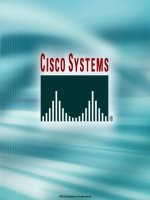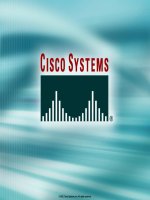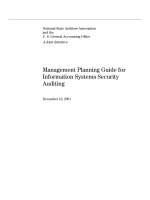Cisco Systems - Enabling OSPF pot
Bạn đang xem bản rút gọn của tài liệu. Xem và tải ngay bản đầy đủ của tài liệu tại đây (396.04 KB, 15 trang )
© 2002, Cisco Systems, Inc. All rights reserved.
© 2002, Cisco Systems, Inc. All rights reserved. ICND v2.0—5-2© 2002, Cisco Systems, Inc. All rights reserved. 2
Enabling OSPF
© 2002, Cisco Systems, Inc. All rights reserved. ICND v2.0—5-3
Objectives
Upon completing this lesson, you will be
able to:
•
Describe the features and operation of OSPF
•
Use Cisco IOS commands to configure dynamic
routing for a single area OSPF network, given a
functioning router
•
Use show and debug commands to identify
anomalies in dynamic routing operation using
OSPF, given an operational router
© 2002, Cisco Systems, Inc. All rights reserved. ICND v2.0—5-4
Introducing OSPF
•
Open standard
•
Shortest path first (SPF) algorithm
•
Link-state routing protocol (vs. distance vector)
© 2002, Cisco Systems, Inc. All rights reserved. ICND v2.0—5-5
OSPF as a Link-State Protocol
•
OSPF propagates link-state advertisements
rather than routing table updates.
•
LSAs are flooded to all OSPF routers in the area.
•
The OSPF link-state database is pieced together
from the LSAs generated by the OSPF routers.
•
OSPF uses the SPF algorithm to calculate the
shortest path to a destination.
–
Link = router interface
–
State = description of an interface and its
relationship to neighboring routers
© 2002, Cisco Systems, Inc. All rights reserved. ICND v2.0—5-6
OSPF Hierarchical Routing
•
Consists of areas and autonomous systems
•
Minimizes routing update traffic
© 2002, Cisco Systems, Inc. All rights reserved. ICND v2.0—5-7
Shortest Path First Algorithm
•
Places each router at the root of a tree and calculates the
shortest path to each destination based on the cumulative cost
•
Cost = 10
8
/bandwidth (bps)
© 2002, Cisco Systems, Inc. All rights reserved. ICND v2.0—5-8
Configuring Single Area OSPF
Router(config-router)#network address mask area area-id
•
Assigns networks to a specific OSPF area
Router(config)#router ospf process-id
•
Defines OSPF as the IP routing protocol
© 2002, Cisco Systems, Inc. All rights reserved. ICND v2.0—5-9
OSPF Configuration Example
© 2002, Cisco Systems, Inc. All rights reserved. ICND v2.0—5-10
Configuring Loopback Interfaces
Router ID:
•
Number by which the router is known to OSPF
•
Default: The highest IP address on an active interface at the
moment of OSPF process startup
•
Can be overridden by a loopback interface: Highest IP address
of any active loopback interface
© 2002, Cisco Systems, Inc. All rights reserved. ICND v2.0—5-11
Router#show ip ospf interface
Verifying the OSPF Configuration
•
Displays area-ID and adjacency information
Router#show ip protocols
•
Verifies that OSPF is configured
Router#show ip route
•
Displays all the routes learned by the router
Router#show ip ospf neighbor
•
Displays OSPF-neighbor information on a per-interface basis
© 2002, Cisco Systems, Inc. All rights reserved. ICND v2.0—5-12
OSPF debug commands
Router#debug ip ospf events
OSPF:hello with invalid timers on interface Ethernet0
hello interval received 10 configured 10
net mask received 255.255.255.0 configured 255.255.255.0
dead interval received 40 configured 30
Router# debug ip ospf packet
OSPF: rcv. v:2 t:1 l:48 rid:200.0.0.117
aid:0.0.0.0 chk:6AB2 aut:0 auk:
Router#debug ip ospf packet
OSPF: rcv. v:2 t:1 l:48 rid:200.0.0.116
aid:0.0.0.0 chk:0 aut:2 keyid:1 seq:0x0
© 2002, Cisco Systems, Inc. All rights reserved. ICND v2.0—5-13
Summary
•
OSPF is an interior gateway protocol similar to
IGRP, but based on link states rather than
distance vectors.
•
OSPF advertises information about each of its
links rather than sending routing table updates
like a distance vector protocol.
•
The SPF algorithm places each router at the root
of a tree and calculates the shortest path to each
destination based on the cumulative cost
required to reach that destination.
© 2002, Cisco Systems, Inc. All rights reserved. ICND v2.0—5-14
Summary (Cont.)
•
Use the router ospf command to start an OSPF
routing process and the network command to
associate addresses to an OSPF area.
•
You can use any one of a number of show
commands to display information about an
OSPF configuration.
•
To display information on OSPF-related events,
such as adjacencies, flooding information,
designated router selection, and SPF
calculation, use the debug ip ospf events
privileged EXEC command.









